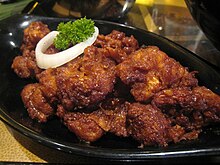Fusion cuisine


Fusion cuisine is cuisine that combines elements of different culinary traditions that originate from different countries, regions, or cultures. Cuisines of this type are not categorized according to any one particular cuisine style and have played a part in innovations of many contemporary restaurant cuisines since the 1970s.[1]
Categories and types[edit]

Fusion food is a general term for the combination of various forms of cookery and comes in several forms. Even though fusion food is often the invention by chefs, fusion cuisine can occur naturally within the different cuisines of a region or sub-region. These can include larger regions, such as East Asian cuisine, European cuisine, and Southwestern American cuisine, as well as more specific and lauded ethnic cuisines such as Chinese cuisine, Japanese cuisine, Korean cuisine, French cuisine, Italian cuisine, and New Mexican cuisine.
Chefs within Asian fusion restaurants combine the various cuisines of different Asian countries, have become popular in many parts of the United States and United Kingdom. Often featured are East Asian, Southeast Asian, and South Asian dishes alongside one another and offering dishes that are inspired combinations of such cuisines.[2] California cuisine is considered a fusion culture, taking inspiration particularly from Italy, France, Mexico, the idea of the European delicatessen, and East Asia, and then creating traditional dishes from these cultures with non-traditional ingredients - such as California pizza. One major example is Oceanic cuisine, which combines the different cuisines of the various island nations.[3] In the United Kingdom, fish and chips can be seen as an early fusion dish due to its marrying of ingredients stemming from Jewish, French, and Belgian cuisines.[4][5] Filipino cuisine is also sometimes characterized as the "original Asian fusion cuisine", combining native culinary traditions and ingredients with the very different cuisines of Spain, Latin America, China, and the United States, among others, due to its unique colonial history.[6]
In Australia, due to the increasing influx of migrants, fusion cuisine is being reinvented and is becoming increasingly the norm at numerous cafes and restaurants, with Modern Australian Asian-fusion restaurants like Tetsuya's in Sydney ranking highly in The World's 50 Best Restaurants. Another incarnation of fusion cuisine implements a more eclectic approach, which generally features original dishes that combine varieties of ingredients from various cuisines and regions. Such a restaurant might feature a wide variety of dishes inspired by a combination of various regional cuisines with new ideas.[7] Foods in Malaysia (also Indonesia) are another popular example of fusion cuisine between Malay, Javanese, Chinese and Indian and light influences from Thai, Portuguese, Dutch, and British cuisines.[8]
Foods based on one culture, but prepared using ingredients and flavors inherent to another culture, are also considered forms of fusion cuisine. For instance, pizza made with cheddar and pepper jack cheese, salsa, refried beans or other common taco ingredients is often marketed as "Taco Pizza".[9] This particular dish is a fusion of Italian and Mexican cuisines. Similar approaches have been used for fusion-sushi, such as rolling maki with different types of rice and ingredients such as curry and basmati rice, cheese and salsa with Spanish rice, or spiced ground lamb and capers rolled with Greek-style rice and grape leaves, which resembles inside-out dolmades. Some fusion cuisines have themselves become accepted as a national cuisine, as with Peruvian Nikkei cuisine, which combines Japanese spices and seasonings and Peruvian ingredients like ají (Peruvian peppers) with seafood. A quintessential Peruvian Nikkei dish is 'Maki Acevichado' or ceviche roll, containing Peruvian-style marinated fish rolled up with rice, avocado, or seaweed."[10]
Background[edit]

This type of restaurant's success depends on a number of factors. Among these are:
- Clientele's (or prospective clientele's) cultural diversity
- Clientele's travel patterns and experiences.
- Clientele's culinary sophistication and openness to new eating experiences.
Wolfgang Puck is attributed as one of the pioneers of fusion cuisine, with some dispute.[11] However, his restaurant Chinois on Main was named after the term attributed to Richard Wing, who in the 1960s combined French and Chinese cooking at the former Imperial Dynasty restaurant in Hanford, California.[12]
See also[edit]
- 2010s in food
- Tex-Mex
- Korean-Mexican fusion
- Yōshoku, a style of Western-influenced cooking in Japan, primarily consisting of Japanized forms of European dishes
- Betawi cuisine
- California cuisine
- Eurasian cuisine of Singapore and Malaysia
- Modern Australian cuisine
- New American cuisine
- Nouvelle cuisine
- Peranakan cuisine
- Sushi burrito
- Sushi pizza
- Indian Chinese cuisine
- Chifa
- Migrants' food consumption
References[edit]
- ^ Lindsey, Robert (1985-08-18). "California grows her own cuisine". New York Times.
- ^ "Asian Cuisine & Foods : Asian-Nation :: Asian American History, Demographics, & Issues". Asian-Nation. Retrieved 2017-11-30.
- ^ "What is Fusion Cuisine?". Wise Geek. Retrieved 2012-05-31.
- ^ Black, Les (1996). New Ethnicites And Urban Cult. Oxford: Routledge. p. 15. ISBN 978-1-85728-251-1.
- ^ Alexander, James (18 December 2009). "The unlikely origin of fish and chips". BBC News. Retrieved 16 July 2013.
- ^ Halpern, Sue; McKibben, Bill (May 2015). "Filipino Cuisine Was Asian Fusion Before "Asian Fusion" Existed". Smithsonian Magazine. Smithsonian Institution. Retrieved 16 December 2018.
- ^ "World Food Cuisines". Retrieved 16 Nov 2016.
- ^ "Asia's original fusion food". Mark C O'Flaherty. Retrieved 2012-07-06.
- ^ "Taco Pizza Recipe". All Recipes. Retrieved 2012-05-31.
- ^ Takenaka, Ayumi (2017). "Immigrant integration through food: Nikkei cuisine in Peru". Contemporary Japan. 29 (2): 117–131. doi:10.1080/18692729.2017.1351022.
- ^ "Sorry, Wolfgang, Fusion Foods Have Been With Us for Centuries". Smithsonian. Retrieved 26 May 2017.
- ^ Khokha, Sasha (2005-07-15). "In Rural California, an Imperial Dynasty Ends". National Public Radio.
External links[edit]
 Media related to Fusion cuisine at Wikimedia Commons
Media related to Fusion cuisine at Wikimedia Commons
No comments:
Post a Comment